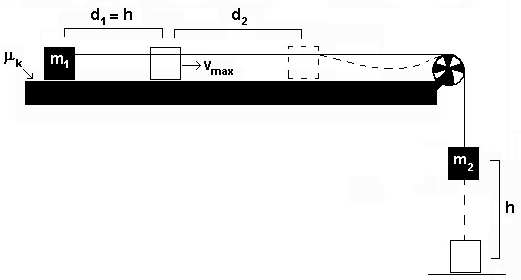
You can also click on the picture to download it in gif format.

You can also click on the picture to download it in gif format.
A falling weight pulls a block about half-way across a table before it hits the floor. This is Phase I--call the distance travelled "D1". When the weight hits the floor, the block stops. Further information on Theory, Apparatus, Procedure, and Helpful Hints is available. The equipment for this demo is available in Rockerfeller 402 & 403.
The purpose is to demonstrate the concept of energy lost due to friction and work done on a system by friction.
The motion of such a system would proceed in two parts (phase 1 and phase 2). In phase 1, the mass (m2) falling from a measured height will "eat up" a known amount of potential energy during its fall from a height (h). This will be jointly transformed into the kinetic energy of the system (block and mass) and the heat evolved by friction. In phase 2, mass m2 dissipates its kinetic energy by impacting the floor and removes itself from further affecting the problem. The sliding block will have acquired a certain amount of kinetic energy. It will then slide to a halt at some distance proportional to this energy.
Derivation: It is possible to write an equation describing what becomes of all the potential energy given by the fall of m2. This energy will appear in the kinetic energies of both masses (the block and m2) and a missing quantity. This quantity is the work done by friction. From this, different quantities can be derived, depending on the information given the class. If the masses and distances are known it is possible to calculate the coefficient of friction by substitution. If the coefficient is calculated beforehand, it is possible to find one of the masses. If the masses and the coefficient are given, the distances can be found. V1 can be found, and measured approximately with a photogate, but that is not necessary--this experiment can be done without any timing device.
The Phase-One Equations are:
Equipment needed:
The height of the mass is measured with the block at the back of the board. The meter stick is then placed on the board so that the distance the block travels can be measured. The block is then released and its displacement measured after it has slid to a halt.
To return to the Mechanics Demo Catalogue .